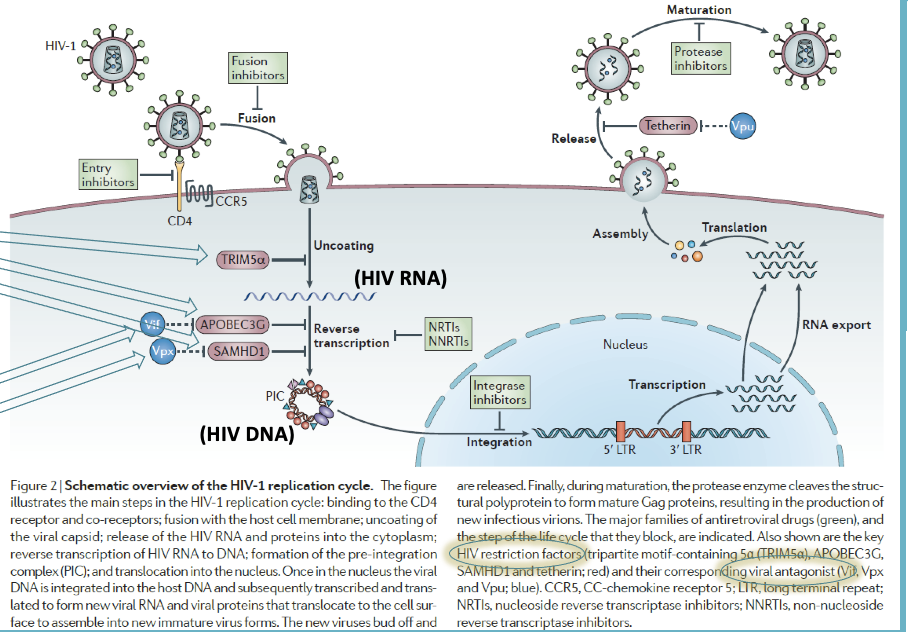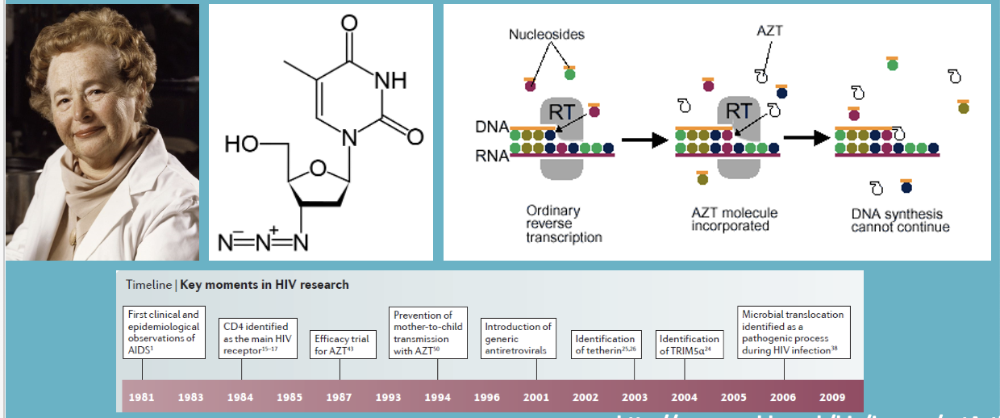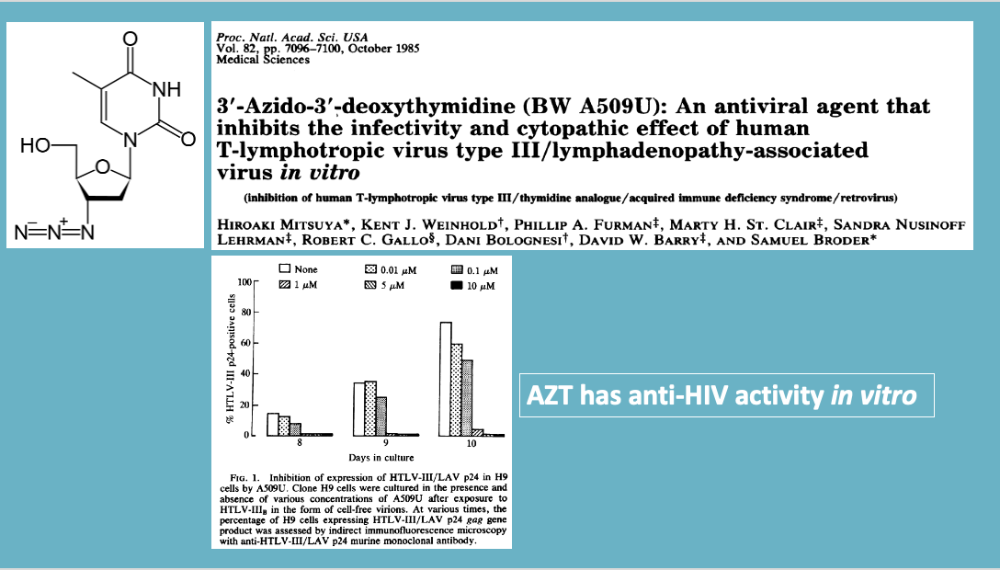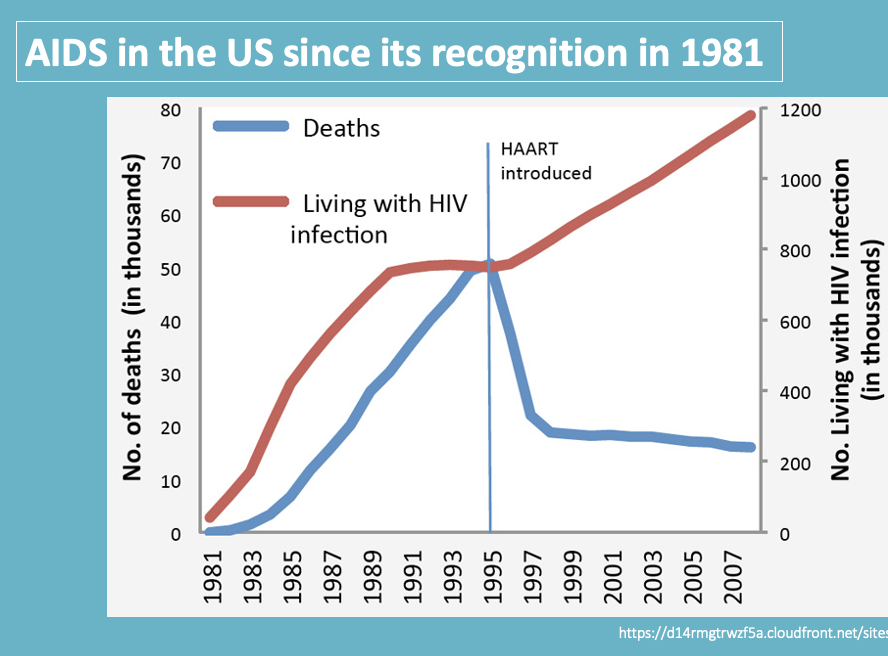When it’s stated that once infected one can’t be ‘cured’ of HIV, this means that such an individual will...
a. …eventually develop AIDS.
b. …be permanently infected with HIV
ANSWER: B (be permanently infected with HIV)
Treating the symptoms of ‘secondary’ opportunistic infections
‘Targeting’ HIV itself
Can we inhibit transmission?
before 1987 could only target opportunistic infections
could NOT target HIV at this point
potential "targets" to block the HIV cellular replication cycle

human cells try to fight back (restriction factors)
- human cells have processes that fight viruses (like HIV) -> factors in cells. Evolved ways to fight intracellular infection
-
if have this, then why does HIV succeed???
- HIV has ways to counteract/inhibit cellular mechanisms that fight HIV
- HIV evolves these like all viruses do
unfortunately, HIV tries to prevent the restriction factors from working (viral antagonists)
figure:
- HIV binding to CD4 receptor + coreceptor
- fusion w/ host cell membrane
- uncoating viral capsid
- release up HIV RNA and proteins into cytoplasm
- reverse transcription RNA -> DNA now
- formation of pre-integration complex (PIC) + translocation into the nucleus
- in nucleus, viral DNA integrated into host DNA and subsequently transcribed + translated to form new viral RNA and viral proteins that translocate into the cell surface to assemble into new immature virus forms
- new viruses bud off + released
- maturation: protease enzymes cleave structural polyproteins to form mature Gag proteins = new infectious virions
- key HIV restriction factors and corresponding viral antagonists exhist
1 reason why cellular infection cycle began
we want drugs to inhibit individual steps
1st drug against HIV: blocks reverse trasncriptase (unique characteristic of the virus compared to our body)
reverse transcriptase discovery: 1970s synthesizing DNA from an RNA template
published in nature june 27th 1970
- viral RNA-dependent DNA polymerase: RNA-dependent DNA polymerase in virions of rous sarcoma virus 1211
- temin + baltimore were awarded nobel prize in 1975 for upending the "central dogma"
- not sure abt what this slide is saying (slide 8)
AZT

- 1970s, gertrude elion developed AZT drug as nucleoside analog
specific for viral reverse transcriptases
- mimics thymine, becomes incorporated and reverse transcriptase cannot extend chain of nucleotides
- AZT = chain terminator (name of drug class)
- in 1970s, there was effort to get anti-retroviral drugs to fight HIV
AZT cont.

- AZT was forgotten about until 1983 when realized retrovirus
caused disease to try to prevent HIV replication
- paper made
to show that AZT may work for HIV
- in vitro - inhibited HIV replication in dish/culture
- figure:
- cultured cells infected w/ HIV, no drug or increasing amounts of AZT
- amount cells HIV+ being measured
- cells not treated: day 8, 15%, day 9, almost 40%, day 10 about 75%
- cells treated: much reduced replication of HIV
- paper made
to show that AZT may work for HIV
- AZT has anti-HIV activity in vitro
double blind study using AZT for HIV patients
6x per week 250 mg AZT or placebo
24 week period
results:
- 19 placebo and 1 AZT died during study
- opportunistic infection in 45 subjects w/ placebo and 24 w/ AZT
- statistically significantly increase in # CD4 cells noted in AZT subjects
- data showed that AZT administration can decrease mortality and frequency of opportunistic infections in selected group of subjects w/ AIDS or its related complex
- probability of developing oppotunistic infection was 0.23 vs 0.43
- this was the 1st time a drug had some efficacy to slow down the virus
AZT cont.
good:
- AZT slowed down viral replication reducing viral load
- prolonged life for about 1 year
bad:
- initially used in doses (about 1500 mg) that had toxic side effects
-
rapid appearance of AZT-resistant HIV
- AZT resistant strains emerged
- made new reverse transcriptase, mutated to have ability to remove AZT from chain
AIDS in US since its recognition in 1981

only in mid 90s was there a decrease in death rate
1996: being diagnosed w/ AIDS no longer became death sentence
- used drug cocktails
-
KNOW: 1996 considered the MIRACLE YEAR
- figured out how to keep HIV from killing people
- new class of drugs discovered
- started to also be used in combination (drug cocktails)
- 1 of most
powerful developed = protease inhibitors
- AZT was for reverse transcriptase, while protease inhibitors act on late phase
- protease - scissors to free proteins = functional proteins
- if protease prevented -> proteins cannot be freed to function and resulting virion is NOT infectious
- THIS drug BINDS to protease + prevents it
- protease inhibitors in combination w/ other drugs = sufficient to suppress HIV virus (keep viral level low/suppressed) = prevents onset of AIDS
- drugs today keep HIV so low that cannot detect it bc of using prinicple of drug mixture
KNOW: 1996 considered
the MIRACLE YEAR
WHO list of essential medicines
...
Eras + milestones of AIDS/HIV in the USA
1) 1981-1983
2) 1983-1987
3) 1987 – could slow down replication
4) 1996 - miracle year
5) Current ( still no cure or vaccine )
in last 28 years, progress has been made, but no cure or vaccines
we HAVE figured out how to prevent transmission